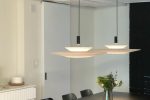Table lamps have a long history dating back to ancient civilizations. The Greeks and Romans used oil lamps made of clay or metal, with wicks drawing oil from reservoirs to produce light. As technology progressed, candles and gas lamps were introduced.
The modern table lamp Vololighting began to emerge in the late 17th century with the invention of the Argand lamp, which featured a cylindrical wick and glass chimney for brighter, more consistent light. This innovation led to the development of electric table lamps in the late 19th century, revolutionizing home lighting. Today, table lamps are available in diverse styles, materials, and designs, serving both functional and aesthetic purposes.
Their evolution continues, with modern LED fixtures representing the latest advancements in lighting technology. Throughout history, table lamps have remained an essential element in interior design, providing practical illumination and decorative appeal to various spaces.
The Versatility of the Table Lamp
Versatility in Design
Table lamps come in a wide range of sizes, shapes, and styles, making them suitable for any space, from a small bedside table to a grand foyer. Whether you’re looking for a sleek and modern design or a more traditional and ornate style, there is a table lamp to suit every taste and decor.
Functional Flexibility
Table lamps also offer versatility in their functionality. They can provide ambient lighting to create a warm and inviting atmosphere, or task lighting for reading or working. Some table lamps even come with adjustable arms or shades, allowing you to direct the light exactly where you need it.
Customization and Materials
Additionally, many table lamps are equipped with dimmer switches, giving you control over the brightness of the light to suit your mood or needs. In terms of materials, table lamps can be made from a variety of materials such as glass, ceramic, metal, or wood, allowing them to complement any design scheme. Whether you prefer a minimalist look or a more eclectic style, there is a table lamp out there that will enhance your space and add a touch of personality.
The Impact of Table Lamps on Interior Design
Table lamps play a crucial role in interior design, as they not only provide illumination but also contribute to the overall aesthetic of a room. The right table lamp can serve as a focal point or accent piece, adding visual interest and personality to any space. Whether you’re looking to create a cozy reading nook or add a touch of elegance to your living room, the right table lamp can help you achieve your desired look and feel.
In addition to their decorative function, table lamps also have the power to influence the mood and ambiance of a room. Soft, warm lighting can create a relaxing and intimate atmosphere, while brighter light can energize and invigorate a space. By strategically placing table lamps throughout a room, you can create layers of light that enhance the overall design and functionality of the space.
Furthermore, table lamps can be used to highlight specific areas or objects within a room, such as artwork, plants, or architectural features. By directing light onto these focal points, you can draw attention to them and create visual interest. In this way, table lamps serve as both practical lighting sources and decorative elements that contribute to the overall harmony and balance of a room’s design.
Choosing the Right Table Lamp for Your Space
When selecting a table lamp for your space, there are several factors to consider to ensure that it meets your functional and aesthetic needs. The first consideration is the size of the lamp in relation to the surface it will be placed on. A lamp that is too large or too small for its intended location can throw off the balance of the room and detract from its overall design.
It’s important to choose a lamp that is proportionate to the surface it will sit on, whether it’s a bedside table, console table, or desk. The style of the lamp is another important consideration. The design of the lamp should complement the existing decor of the room while also adding visual interest.
Whether you prefer a sleek and modern look or a more traditional and ornate style, there are countless options available to suit your taste and preferences. Additionally, consider the function of the lamp and the type of lighting it will provide. If you need task lighting for reading or working, look for a lamp with an adjustable arm or shade that can direct light where you need it.
If you’re looking for ambient lighting to create a warm and inviting atmosphere, consider a lamp with a soft shade that diffuses light gently. Finally, consider the material and color of the lamp in relation to the rest of the room’s decor. A lamp made from glass or metal can add a touch of modern elegance, while a ceramic or wooden lamp can bring warmth and texture to the space.
The color of the lamp should also complement the color scheme of the room, whether it’s by blending in seamlessly or making a bold statement.
The Environmental Impact of Table Lamps
As society becomes increasingly aware of environmental issues, there is growing concern about the impact of lighting on the environment. Traditional incandescent bulbs consume large amounts of energy and have a relatively short lifespan, contributing to energy waste and pollution. However, advancements in lighting technology have led to more energy-efficient options such as LED and CFL bulbs, which consume less energy and have longer lifespans.
When choosing a table lamp, consider opting for one that is compatible with LED or CFL bulbs. These types of bulbs not only reduce energy consumption but also produce less heat, making them safer and more environmentally friendly. Additionally, LED bulbs are available in a wide range of color temperatures and can be dimmable, giving you greater control over the ambiance and energy usage in your space.
Another consideration for reducing the environmental impact of table lamps is to choose lamps made from sustainable materials. Look for lamps made from recycled or renewable materials such as bamboo, reclaimed wood, or recycled glass. By choosing eco-friendly materials, you can minimize your carbon footprint while still enjoying beautiful and functional lighting in your home.
Furthermore, consider the lifespan and durability of the table lamp when making your selection. Investing in a high-quality lamp that will last for many years reduces the need for frequent replacements, which in turn reduces waste and consumption of resources. By making conscious choices about the type of bulbs and materials used in your table lamp, you can minimize its environmental impact while still enjoying its practical and aesthetic benefits.
Table Lamps as Functional Art
The Art of Table Lamp Design
Many contemporary designers view table lamps as an opportunity to showcase creativity and craftsmanship. They experiment with unconventional materials, shapes, and textures to create unique and eye-catching designs that go beyond mere functionality. These artistic table lamps can become conversation starters and add personality to any room, reflecting the homeowner’s individuality and taste.
Functional Art Pieces
In addition to their aesthetic appeal, table lamps can also be functional art pieces that serve specific purposes beyond lighting. Some table lamps are designed with built-in features such as USB ports for charging devices, adjustable arms for directing light precisely where it’s needed, or integrated speakers for playing music. These innovative designs combine form and function in exciting ways that cater to modern lifestyles while adding an element of surprise and delight to everyday objects.
Elevating Interior Design
With their unique blend of style, creativity, and functionality, table lamps can elevate interior design to new heights. By choosing a table lamp that reflects your personal style, you can add a touch of sophistication and elegance to any room, making it a true reflection of your personality and taste.
The Future of Table Lamps in Modern Design
As technology continues to advance at a rapid pace, so too does the future of table lamps in modern design. With the rise of smart home technology, table lamps are becoming increasingly integrated into connected home systems that allow for remote control and automation. Smart table lamps can be controlled via smartphone apps or voice commands, offering customizable lighting options that adapt to different activities or moods.
Furthermore, advancements in lighting technology have led to more sustainable and energy-efficient options for table lamps. LED bulbs continue to improve in terms of brightness, color accuracy, and dimming capabilities while consuming less energy than traditional incandescent bulbs. As environmental concerns become more pressing, we can expect to see an increasing emphasis on eco-friendly materials and energy-efficient lighting solutions in future table lamp designs.
In terms of aesthetics, we can anticipate continued innovation in design as contemporary artists and designers push boundaries with new materials, shapes, and forms. The boundaries between art and design continue to blur as designers create sculptural table lamps that challenge traditional notions of what a lamp should look like. These experimental designs offer exciting possibilities for incorporating table lamps as statement pieces that contribute to the overall artistic expression of a space.
In conclusion, table lamps have come a long way from their ancient origins as simple oil lamps to become essential elements of interior design that combine functionality with artistic expression. As we look towards the future, we can expect to see continued innovation in technology, sustainability, and design that will further elevate the role of table lamps in modern living spaces. Whether it’s through energy-efficient lighting solutions, sustainable materials, or boundary-pushing designs, table lamps will continue to illuminate our homes while adding beauty and character to our living spaces.




